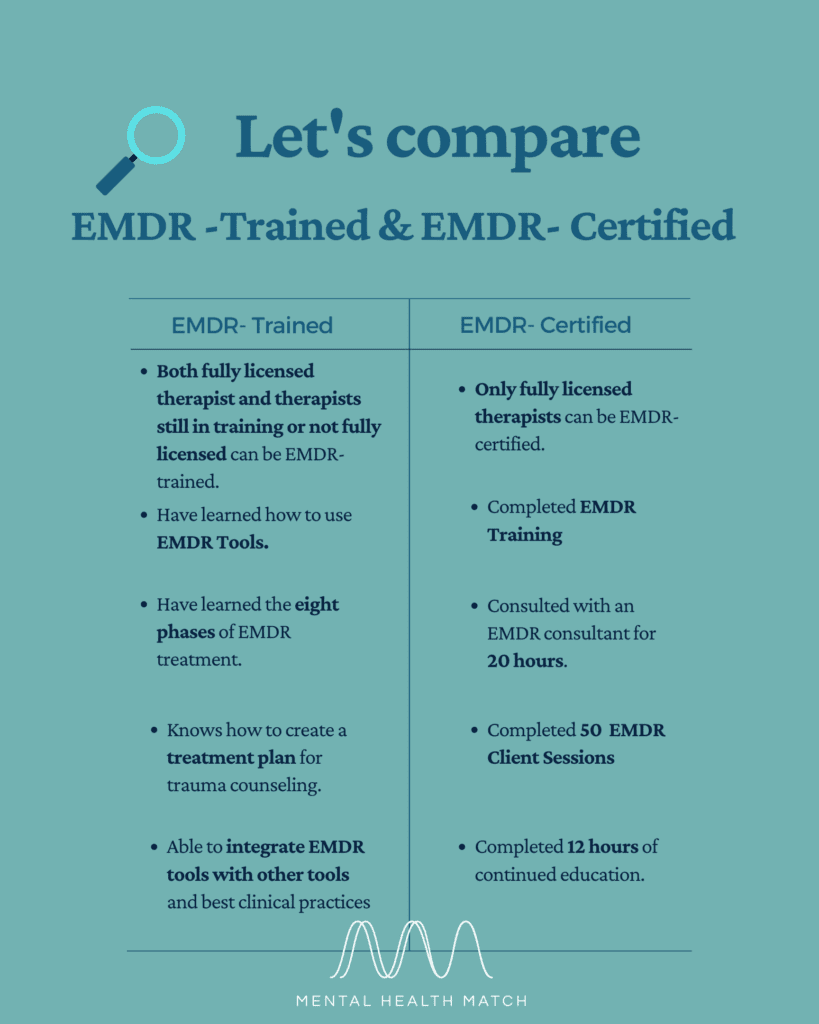Eye Movement Desensitization and Reprocessing (EMDR) has become a popular type of therapy to help people heal from painful memories and traumatic events. This article will cover all the information you need to know about EMDR therapy, who it can help, what to look for in an EMDR therapist, and how to find an EDMR therapist near you.
What Is EMDR Therapy?
Francine Shapiro developed EMDR as a way for clients who would tend to intellectualize their problems to become more grounded in their feelings. Shapiro discovered that people can reduce the impacts of trauma by moving their eyes back and forth while recalling an intense memory. Shapiro encouraged clients to heal traumas by going through their experiences in their minds, rather than running away from them.
What does EMDR stand for?
EMDR stands for Eye Movement Desensitization and Reprocessing. It is called this because it is a therapy that uses eye movement to help someone desensitize painful or traumatic memories and then reprocess them to create new responses to those memories.
How does EMDR therapy work?
EMDR is a therapeutic approach that works by stimulating both sides of the brain while reassociating a painful memory with a new, more helpful story. By activating vision in both eyes, research shows this “bilateral stimulation” helps the brain create new associations with memories while bypassing areas of the brain and mind that are stuck in traumatic responses.
For example, a person who has had a traumatic event or disturbing experience, such as having been assaulted, may be stuck in patterns of emotional distress, self-blame, nightmares, flashbacks, and intrusive thoughts. During EMDR, the person can create new associations with the painful memory, helping their brain realize they are not at fault and are now safe. This can help people find peace and resolution after traumatic experiences.
You can do EMDR therapy online, or with a certified EMDR therapist near you.
What does an EMDR therapy treatment session look like?
While there is no universal script for an EMDR therapy session, you can expect to go through eight phases of EMDR treatment, typically in 6-12 sessions that last 60-90 minutes:
- Context: a trained EMDR therapist will get to know your experiences and help you prioritize a treatment plan and create a safe space.
- Prepare: Your EMDR therapist will help you plan for what to expect, make sure you feel safe, and are prepared to regulate yourself if revisiting a traumatic memory becomes too overwhelming.
- Recall the memory: You will then identify the specific intense memory you want to heal.
- Stimulate both eyes: During this phase of the EMDR process, you will focus on the painful memory while engaging in rapid eye movements back and forth.
- Install a new memory: While you engage in eye movement, you will also think about a more positive, helpful, and peaceful perspective to replace your negative thoughts.
- Body scan: Once the most intense parts of EMDR therapy are completed, your therapist will then guide you to check your body for remaining tension.
- Closure: Finally, you will use tools to regulate your emotions, calm yourself, and restore balance after the session.
- Reevaluation of treatment: Periodically, your therapist will work with you to evaluate if EMDR treatment is meeting your goals.
These steps and techniques are common in the EMDR process, however, it is important to note that many certified EMDR clinicians work in an integrative modality, bringing in tools and techniques from many therapy styles and therapeutic approaches (such as Cognitive Behavioral Therapy). At times, clinicians may integrate EMDR into their work in a more subtle and less strict way.
What is the difference between brainspotting vs EMDR
Both brainspotting and EMDR can help you heal traumatic memories. However, EMDR relies on bilateral stimulation of moving both eyes, while brainspotting usually involves focusing your eyes on one spot. If the rapid eye movement of EMDR is too distracting for you, you may want to try brainspotting.
Is EMDR similar to hypnosis?
Hypnosis was not specifically designed for trauma in the way EMDR was and EMDR has more proven long-lasting effects. Unlike EMDR, hypnosis will put you in a trance-like state that leaves you open to pre-determined suggestions and goals. EMDR does not bring you into a trance as it relies on you consciously and intentionally engaging with your memories.
Who Can EMDR Help?
EMDR has been proven effective for people who have experienced trauma. This can include people with Post-Traumatic Stress Disorder (PTSD), such as military veterans, and people who have experienced violence, abuse, or assault.
In recent years, EMDR has become a powerful tool for people in emotional distress because of experiences other than trauma. This is because EMDR helps ground you in the present, instead of a past memory, with an emphasis on evaluating what today’s danger really is.
What disorders can EMDR treat?
Research shows EMDR is a helpful mental health modality for those with:
- anxiety
- chronic pain
- depression
- dissociative disorders
- eating disorders
- grief
- panic attacks
- personality disorders
- phobias, and
- trauma
Does EMDR work?
Studies have indicated that EMDR not only works, but that its effects last over time. Especially around topics of trauma, one study demonstrated that EMDR was 90% effective at eliminating Post-Traumatic Stress Disorder (PTSD) symptoms. However, it is important to note that EMDR requires an incredible amount of therapist-client collaboration and trust.
How long does it take for EMDR to work?
If you are treating a single traumatic memory, you can expect to feel better in about three sessions. Multiple and complex traumas may take longer.
What To Look For In An EMDR Therapist
It is easy to find an EMDR therapist, either online or near you. When searching for an EMDR therapist, you may wish to know some keywords that can help you determine which EMDR therapist is best for you.
What is the difference between EMDR-trained and EMDR-certified?
- EMDR-trained means the therapist has learned how to use the tools of EMDR effectively, the eight phases of EMDR treatment, how to create a treatment plan for trauma counseling, and how to integrate EMDR with other tools and best clinical practices. Therapists still in training who are not fully licensed can be EMDR-trained.
- EMDR-certified means the therapist has completed all the elements of EMDR training plus: consulted with an EMDR consultant for 20 hours, completed 50 EMDR client sessions, and completed 12 hours of continued education. Only therapists who are fully licensed can be EMDR-certified.

It is also important to note that the best EMDR therapist for you is not solely based on licenses, credentials, or certificates. The best EMDR therapist for you is the one that you can see yourself building a connection with, developing trust in over time, and whose clinical practices, such as fees and availability align with your needs.
Can you do EMDR online?
Yes, EMDR can be successfully and ethically conducted online. Online EMDR became more popular over the past few years. If you have complex and very painful trauma, you may benefit from doing EMDR in person because you’ll have a trusted and trained professional in the room with you as you recall distressing memories.
Does insurance cover EDMR therapy?
Yes, most insurances that cover talk therapy will cover EMDR treatments. However, EMDR sessions can be longer than the typical 50-minute mental health session usually covered by insurance. You should check with your insurance provider to understand the types and quantity of sessions your plan will cover.
Furthermore, some insurances will cover EMDR treatment for PTSD and trauma, but not for other types of anxiety or mood disorders. Always check with your insurance to understand the diagnoses for which EMDR is covered, as well as how EMDR works with your usual co-pays and deductibles.
How To Find An EMDR Therapist
There are a number of ways to find an EMDR therapist who meets your needs and is a good fit, including insurance, budget, personal preferences, and in-person/remote.
How to find certified EMDR therapists near me
Like all therapies, you can be treated by only a clinician who is licensed in the state in which you live. To find an EMDR therapist who can treat you, consider the following options:
- For the quickest way, enter your zip code here to find fully licensed EMDR therapists in your community.
- Ask your usual therapist, primary care provider, or medical provider.
- Use your insurance directory
- Use this directory from the EMDR International Association, or this one from the EMDR Institute, although results may be limited based on your location
How to choose an EMDR therapist
As you evaluate your options, remember that looking for a therapist who is a good fit is an intimate journey. Since people often seek EMDR therapists to process trauma, compatibility and a sense of safety are most important when looking for an EMDR professional. You should look for a therapist who you feel comfortable with, can trust, and can see yourself building a relationship with. This means looking for a certified EMDR therapist who has competence in the issues you are struggling with, a cultural fit, and a personality that works for you.
If you have complex or multiple traumas, you may wish to find a more experienced therapist who is EMDR-certified and fully licensed.
If you are considering EMDR, it is best to first talk with a trained medical provider, including an EMDR therapist, for more information. And if you need help finding a therapist who works for you, please reach out to us and we will personally help get you connected.
